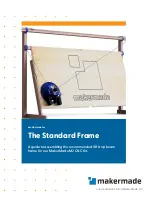
3
In these safety instructions the word “product”
refers to the Monochrome CRT Viewfinder Unit
FU-1000.
1. Read Instructions — All the safety and
operating instructions should be read before
the product is operated.
2. Retain Instructions — The safety and
operating instructions should be retained for
future reference.
3. Heed Warnings — All warnings on the
product and in the operating instructions
should be adhered to.
4. Follow Instructions — All operating and
maintenance instructions should be followed.
5. Cleaning — Unplug this product from the wall
outlet before cleaning. Do not use liquid or
aerosol cleaners. The product should be
cleaned only as recommended in this
manual.
6. Accessories — Do not use accessories not
recommended in this manual as they may be
hazardous.
7. Avoid magnetic or electric fields — Do not
use the camera close to TV transmitters,
portable communication devices or other
sources of electric or magnetic radiation.
They may cause picture interference, or
permanently damage the camera.
8. Water and Moisture — Hazard of electric
shock — Do not use this product near water
or in rainy/moist situations.
9. Placing or Moving — Do not place on an
unstable cart, stand, tripod, bracket or table.
The product may fall, causing serious injury
to a child or adult, and serious damage to the
product.
A product and cart combination should be
moved with care. Quick stops,
excessive force, and uneven
surfaces may cause the
product and cart combination
to overturn.
10.Outdoor Antenna Grounding — If an outside
antenna is connected to the product, be sure
the antenna is grounded so as to provide
some protection against voltage surges and
built-up static charges. Section 810 of the
National Electrical Code, ANSI/NFPA
No. 70—1984, provides information with
respect to proper grounding of the mast and
supporting structure, grounding of the lead-in
wire to an antenna discharge unit, size of
grounding conductors, location of antenna
discharge unit, connection to grounding
electrodes, and requirements for the
grounding electrode. See figure 1.
11.Lightning — For added protection of this
product during a lightning storm, or when it is
left unattended and unused for long periods
of time, disconnect it from the wall outlet and
disconnect the antenna. This will prevent
damage to the product due to lightning and
power-line surges.
12.Power Lines — An outside antenna system
should not be located in the vicinity of
overhead power lines or other electric light or
power circuits, or where it can fall into such
power lines or circuits. When installing an
outside antenna system, extreme care
should be taken to keep from touching such
power lines or circuits as contact with them
might be fatal.
13.Overloading — Do not overload wall outlets
and extension cords as this can result in a
risk of fire or electric shock.
EXAMPLE OF ANTENNA GROUNDING AS
PER NATIONAL ELECTRICAL CODE
ANTENNA
LEAD IN
WIRE
ANTENNA
DISCHARGE
UNIT
(NEC SECTION
810-20)
GROUNDING CONDUCTORS
(NEC SECTION 810-21)
GROUND CLAMPS
POWER SERVICE
GROUNDING ELECTRODE
SYSTEM
(NEC ART 250. PART H)
NEC - NATIONAL ELECTRICAL CODE
ELECTRIC
SERVICE
EQUIPMENT
GROUND
CLAMP
Fig. 1
IMPORTANT SAFETY INSTRUCTIONS




































